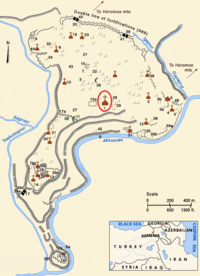Cathedral of Ani
| Cathedral of Ani | |
|---|---|

|
|
| Basic information | |
| Location | Ani, Kars Province, Turkey |
| Geographic coordinates | 40°30′22″N 43°34′23″E / 40.506206°N 43.572969°ECoordinates: 40°30′22″N 43°34′23″E / 40.506206°N 43.572969°E |
| Affiliation | Armenian Apostolic Church |
| Country | Turkey |
| Architectural description | |
| Architect(s) | Trdat |
| Architectural type | Domed basilica |
| Architectural style | Armenian |
| Groundbreaking | 989 |
| Completed | 1001 or 1010 |
| Specifications | |
| Length | 34.3 m (113 ft) |
| Width | 24.7 m (81 ft) |
| Height (max) | 20 m (66 ft) |
Cathedral of Ani (Armenian: Անիի մայր տաճար, Anii mayr tačar; Turkish: Ani Katedrali) is the largest standing building in Ani, a medieval capital of Armenia, located in present-day eastern Turkey, on the border with modern Armenia. It was completed in the early 11th century by the architect Trdat and was the seat of the Catholicos, the head of the Armenian Apostolic Church, for nearly half a century.
In 1064, following the Seljuk conquest of Ani, the cathedral was converted into a mosque. It later returned to being used as an Armenian church. It eventually suffered damage in a 1319 earthquake when its conical dome collapsed. Subsequently, Ani was gradually abandoned. The north-western corner of the church was heavily damaged by a 1988 earthquake.
The cathedral is considered the largest and most impressive structure of Ani. It is a domed basilica with a rectangular plan, though the dome and most of its supporting drum are now missing. Its use of pointed arches and cluster piers has been widely cited by scholars to have possibly influenced or at least preceded Gothic architecture.
In modern times, the cathedral is usually referred to in Armenian as Անիի մայր տաճար, Anii mayr tačar and in Turkish as Ani Katedrali, both meaning "cathedral of Ani". Historically, however, it was known in Armenian as Անիի Կաթողիկե, Anii Kat'oghike. The cathedral has also been referred to as Holy Mother of God Church of Ani (Armenian: Անիի Սուրբ Աստվածածնի եկեղեցի, Anii Surb Astvatsatsni yekeghetsi;Turkish: Meryem Ana Katedral) or Great Cathedral of Ani (Մեծ Կաթողիկե, Mets Kat'oghike;Büyük Katedral).
Following more than two centuries of Arab rule, Armenia gained independence with the leadership of the Bagratid (Bagratuni) dynasty around 885. Ani was made capital in 961 and it soon emerged as a prosperous urban center. The construction of the cathedral began in 989. The architect Trdat was commissioned by Bagratid King Smbat II to build a cathedral in the new capital of the Armenian kingdom. The construction was halted when Smbat died in 989, according to an inscription on the south wall. Meanwhile, Trdat was hired to direct the repairs of the dome of the Hagia Sophia in Constantinople, which had collapsed in an earthquake. Trdat returned from Constantinople in 993. The construction was continued and completed by Queen Katranide (Katramide), the wife of King Gagik I, Smbat's brother and successor. It was completed either in 1001 or 1010. According to Christina Maranci the generally accepted date of completion is 1001, but it may have extended until 1010. The contradiction is based on the reading of the inscription of the cathedral's northern wall. The cathedral served as the seat of the catholicos, the head of the Armenian Apostolic Church from its foundation in 1001 until the mid-11th century (1046 or 1051). Thus, for around half a century Ani was both the religious and secular center of Armenia.
...
Wikipedia

